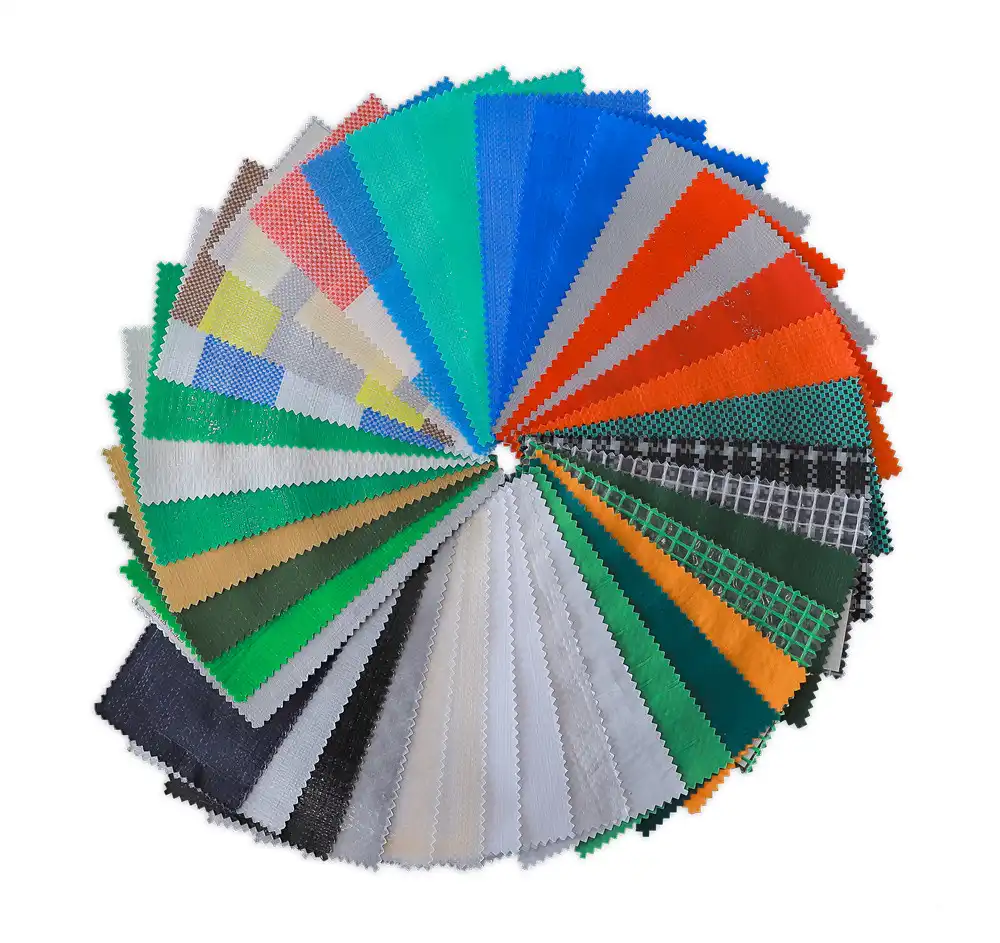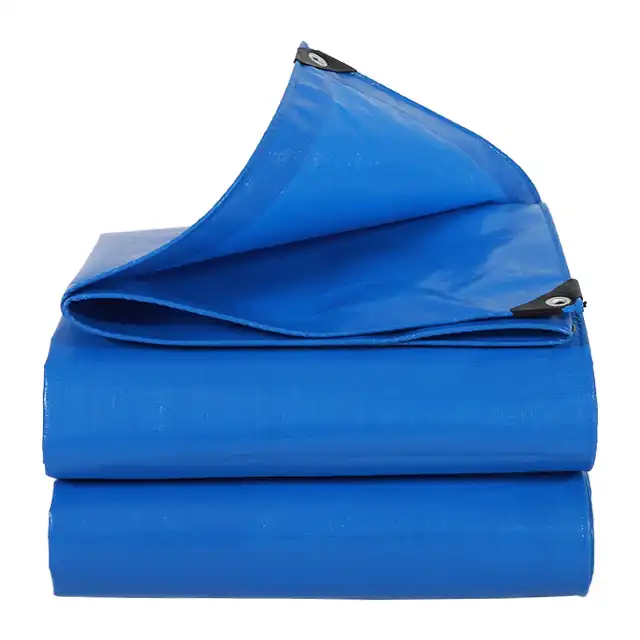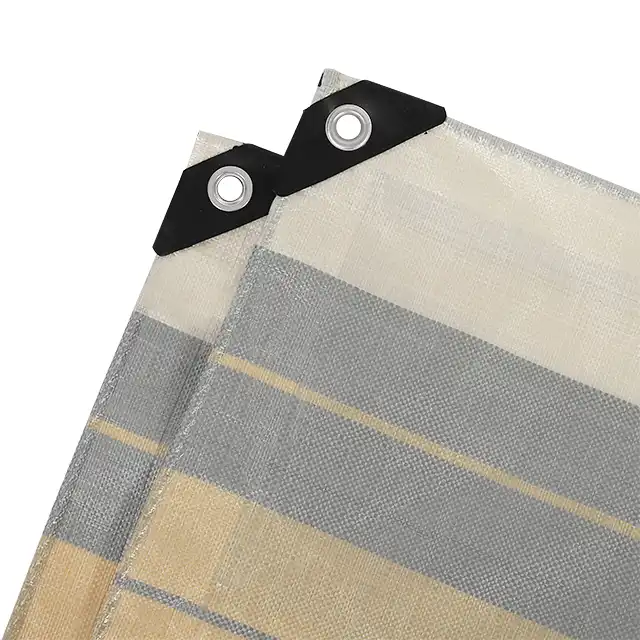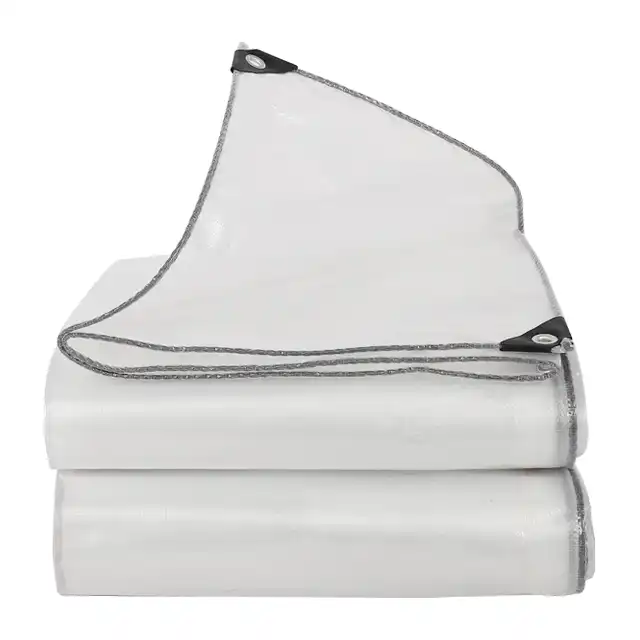Poly Tarps vs. Canvas Tarps: Which Is More Durable
When it comes to protective coverings for various applications, the debate between poly tarps and canvas tarps has been ongoing for years. Both materials offer distinct advantages, but durability often tops the list of concerns for most users. In this comprehensive comparison, we'll explore the durability factors of poly tarps versus canvas tarps, examining their resistance to elements, longevity, and performance in different conditions. Understanding the key differences between these materials can help you make an informed decision based on your specific needs, whether for construction projects, outdoor protection, or industrial applications.
Material Composition and Durability Factors
Structure and Manufacturing Process
 Poly tarps, particularly those of premium quality like those manufactured by Linyi Shengde Plastic Co., Ltd., are constructed from high-density polyethylene (HDPE) woven fabrics with low-density polyethylene (LDPE) coating on both sides. This engineering marvel begins with high-strength yarn extrusion, where specialized machines create yarn thickness ranging from 400D to 2500D. The manufacturing process involves advanced water-jet looms that weave these yarns into tight, resilient sheets. The resulting fabric then undergoes a specialized coating process that adds waterproofing properties and UV resistance. This multi-layer construction creates a material that resists tearing, puncturing, and degradation from environmental factors. The tightly woven polyethylene fibers provide the backbone of strength, while the lamination process on both sides ensures complete protection against moisture. Poly tarps from quality manufacturers use mesh counts ranging from 10×10 to 14×14, creating a durable yet lightweight product with thickness measurements between 7-12 mil. This structured approach to manufacturing results in a product that maintains its protective qualities even after prolonged outdoor exposure.
Poly tarps, particularly those of premium quality like those manufactured by Linyi Shengde Plastic Co., Ltd., are constructed from high-density polyethylene (HDPE) woven fabrics with low-density polyethylene (LDPE) coating on both sides. This engineering marvel begins with high-strength yarn extrusion, where specialized machines create yarn thickness ranging from 400D to 2500D. The manufacturing process involves advanced water-jet looms that weave these yarns into tight, resilient sheets. The resulting fabric then undergoes a specialized coating process that adds waterproofing properties and UV resistance. This multi-layer construction creates a material that resists tearing, puncturing, and degradation from environmental factors. The tightly woven polyethylene fibers provide the backbone of strength, while the lamination process on both sides ensures complete protection against moisture. Poly tarps from quality manufacturers use mesh counts ranging from 10×10 to 14×14, creating a durable yet lightweight product with thickness measurements between 7-12 mil. This structured approach to manufacturing results in a product that maintains its protective qualities even after prolonged outdoor exposure.
Weather Resistance Comparison
When comparing poly tarps and canvas tarps for weather resistance, poly tarps demonstrate superior performance in diverse climate conditions. High-quality poly tarps, such as those from Sendow Tarpaulin, feature specialized UV treatments ranging from 1% to 7%, which significantly extends their lifespan when exposed to direct sunlight. This UV protection prevents the harmful effects of solar radiation, which can cause material breakdown and color fading. Canvas tarps, while naturally resistant to UV rays to some degree, typically require additional treatments to match the level of protection offered by poly tarps. Additionally, poly tarps exhibit exceptional waterproofing capabilities – they're 100% waterproof due to their LDPE coating, which forms an impenetrable barrier against moisture. This makes poly tarps ideal for applications requiring absolute water protection, such as covering sensitive equipment or materials. Canvas tarps, though water-resistant when properly treated, often allow some level of moisture penetration over time, especially at the seams or when exposed to prolonged heavy rainfall. The anti-freezing properties of poly tarps further enhance their weather resistance, allowing them to maintain flexibility and functionality even in arctic conditions, while canvas may become stiff and difficult to handle in freezing temperatures.
Weight vs. Strength Ratio
The weight-to-strength ratio represents a critical factor when evaluating tarp durability, and this is where poly tarps showcase a distinct advantage. Modern poly tarps, especially those manufactured with advanced technology like Sendow's production lines, achieve impressive strength while maintaining relatively light weights ranging from 65gsm to 280gsm. This efficient weight-to-strength ratio makes poly tarps significantly easier to transport, install, and reposition compared to their canvas counterparts. Canvas tarps, while undoubtedly strong, typically weigh substantially more for equivalent protection levels, sometimes weighing 2-3 times more than comparable poly tarps. This additional weight not only complicates handling but can create excessive stress on mounting points and support structures. The tear resistance of high-quality poly tarps further enhances their practical durability – they can withstand substantial tension without developing progressive tears. The manufacturing process employed by leading manufacturers like Linyi Shengde Plastic Co. incorporates high-strength yarns specifically engineered to resist tearing even when punctured or cut. This combination of lightweight construction and superior tear resistance makes poly tarps particularly suitable for applications requiring frequent repositioning or installation in challenging environmental conditions, where the weight-to-strength ratio directly impacts overall usability and functional durability.
Performance in Extreme Conditions
Temperature Tolerance Analysis
Poly tarps demonstrate remarkable performance across extreme temperature ranges, offering advantages that make them particularly suitable for challenging environmental conditions. High-quality poly tarps manufactured by industry leaders like Linyi Shengde Plastic Co. maintain their flexibility and functionality in temperatures ranging from extreme cold to intense heat. This "Arctic Flexibility" feature allows the material to remain pliable and workable even in sub-zero conditions, where canvas often becomes rigid and difficult to handle. The specialized polyethylene composition resists becoming brittle in cold weather, maintaining its protective integrity when other materials would crack or tear. On the opposite end of the temperature spectrum, poly tarps demonstrate excellent heat resistance, with advanced UV treatments preventing degradation from prolonged sun exposure. The laminated structure effectively reflects a portion of solar radiation, helping to keep covered items cooler than canvas alternatives would allow. Additionally, poly tarps resist the expansion and contraction cycles that extreme temperature fluctuations can cause, maintaining dimensional stability that prevents warping or shrinking. This temperature versatility makes poly tarps ideal for year-round outdoor applications in variable climates, from construction sites in northern winters to agricultural coverings in southern summers.
Water and Moisture Protection
When it comes to water and moisture protection, poly tarps offer unparalleled performance that significantly outpaces canvas alternatives. The manufacturing process for premium poly tarps, such as those produced by Sendow Tarpaulin, creates a 100% waterproof barrier through the combination of tightly woven HDPE fabric and comprehensive LDPE coating on both sides. This dual-layer protection prevents any water penetration, even during sustained heavy rainfall or when submerged. The waterproofing isn't limited to the material itself – high-quality poly tarps feature specialized heat-sealed seams that maintain watertight integrity throughout the entire product. This makes poly tarps particularly valuable for applications like truck covers, aquaculture tarps, and emergency shelters where absolute water protection is essential. Canvas tarps, while often treated with water-repellent substances, typically allow some degree of moisture penetration over time, particularly at seams and stress points. Additionally, poly tarps resist mold and mildew growth that can rapidly deteriorate canvas when exposed to persistent moisture. The anti-corrosion properties of poly tarps further enhance their moisture protection capabilities, preventing rust and deterioration of metal objects underneath, which can be especially important for equipment storage and industrial applications. This superior waterproofing extends the functional lifespan of poly tarps in wet conditions, making them more cost-effective for long-term outdoor use despite sometimes higher initial costs compared to basic canvas alternatives.
UV and Chemical Resistance
Poly tarps excel in environments exposed to UV radiation and chemical hazards, offering protection that significantly extends their usable lifespan compared to canvas alternatives. Leading manufacturers like Linyi Shengde Plastic Co. incorporate specialized UV inhibitors directly into the polyethylene material during production, creating tarps with UV protection ratings ranging from 1% to 7%. This integrated approach to UV resistance prevents the material degradation, color fading, and brittleness that typically affects untreated coverings. The UV protection isn't merely a surface treatment that can wear off – it's incorporated throughout the material, ensuring lasting protection even after years of sun exposure. This makes poly tarps particularly valuable for applications in high-UV environments such as construction sites, agricultural coverings, and outdoor storage. Beyond UV resistance, poly tarps demonstrate remarkable chemical resistance that canvas coverings cannot match. The polyethylene composition resists degradation from exposure to many common chemicals, including petroleum products, mild acids, and alkaline substances. This chemical stability makes poly tarps ideal for industrial applications where exposure to potentially corrosive substances is likely. The combination of UV and chemical resistance contributes significantly to the overall durability advantage that poly tarps hold over canvas alternatives, particularly in challenging industrial environments or regions with intense sunlight. While canvas may initially resist some UV exposure, it typically requires frequent retreatment and shows accelerated degradation when exposed to chemicals, substantially reducing its effective lifespan compared to properly manufactured poly tarps.
Applications and Practical Considerations
Industry-Specific Durability Requirements
Different industries demand varying levels of tarp performance, and poly tarps have demonstrated exceptional versatility across diverse sectors. In construction and building applications, poly tarps from manufacturers like Sendow Tarpaulin provide critical protection for materials and equipment against unpredictable weather conditions. Their tear resistance and 100% waterproof properties ensure that expensive building materials remain dry and usable despite rain or snow. The transportation industry benefits significantly from the durability of poly tarps as truck covers, where they must withstand the combined challenges of high-speed wind forces, variable weather conditions, and frequent handling. The anti-freezing and shrink-proof qualities make them particularly valuable for long-haul transportation through changing climate zones. In agricultural settings, poly tarps serve multiple functions from greenhouse fabrics to harvest protection, where their resistance to UV degradation allows for season after season of reliable use. The aquaculture industry depends heavily on impermeable tarps for creating controlled water environments, where any failure could result in significant losses – the chemical resistance and 100% waterproof nature of poly tarps make them ideal for these demanding applications. For energy and mining operations in remote locations, the combination of lightweight construction and extreme durability means poly tarps can be easily transported to sites while providing long-lasting protection for valuable equipment and materials. Each of these industries has found that the specific durability attributes of properly manufactured poly tarps – tear resistance, waterproofing, UV protection, and chemical stability – directly translate to operational efficiencies and cost savings over time when compared to canvas alternatives that may require more frequent replacement.
Cost-Effectiveness Over Time
When evaluating the true cost-effectiveness of protective coverings, the initial purchase price represents only a fraction of the total ownership cost. High-quality poly tarps, such as those manufactured by Linyi Shengde Plastic Co., typically demonstrate superior long-term value despite sometimes higher upfront costs compared to basic canvas options. This economic advantage stems from several durability factors that directly impact replacement frequency. The extended lifespan of properly manufactured poly tarps – often 3-5 years of continuous outdoor use – means fewer replacement purchases over time. The maintenance requirements further enhance their cost advantage; poly tarps require minimal upkeep beyond occasional cleaning, while canvas alternatives often need regular treatments to maintain water resistance and prevent mold growth. This maintenance difference translates to both direct cost savings and reduced labor requirements. Additionally, the protective performance of poly tarps helps preserve the value of covered items – equipment, materials, and products stay drier and cleaner, extending their usable life and maintaining their value. For commercial applications, this protection capability directly impacts operational budgets by reducing damage-related expenses. The lightweight nature of poly tarps also generates indirect cost benefits through easier handling, which requires fewer personnel for installation and repositioning, potentially reducing labor costs. When these factors are combined and analyzed across a multi-year timeframe, the total cost of ownership for quality poly tarps typically proves more economical than canvas alternatives, particularly in demanding environmental conditions where the performance difference becomes most apparent. This cost-effectiveness makes poly tarps the preferred choice for businesses focusing on long-term operational efficiency rather than minimizing initial expenditures.
Environmental Impact and Sustainability
The environmental considerations surrounding tarp selection have become increasingly important for environmentally conscious consumers and businesses. While canvas tarps are derived from natural cotton fibers and can eventually biodegrade, this apparent advantage requires nuanced examination. Modern poly tarps, particularly those produced by forward-thinking manufacturers like Linyi Shengde Plastic Co., offer surprising environmental benefits when the entire lifecycle is considered. Their exceptional durability translates directly to sustainability advantages – a single poly tarp often replaces multiple canvas tarps over the same timespan, reducing the overall resource consumption associated with manufacturing replacement products. The production processes for high-quality poly tarps have become increasingly efficient, with manufacturers implementing energy-saving technologies in their extrusion, weaving, and coating operations. Advanced water-jet looms and precision coating machines minimize waste material during production while ensuring consistent quality that extends useful product life. The lightweight nature of poly tarps reduces transportation-related carbon emissions throughout the supply chain and during product distribution. Additionally, many poly tarp manufacturers now incorporate recycling programs and use partially recycled materials in production when possible. The extended lifespan of poly tarps reduces waste generation over time, particularly important in industrial applications where large quantities of material would otherwise enter the waste stream more frequently. While end-of-life considerations remain an ongoing challenge for polyethylene products, the overall environmental impact assessment increasingly favors high-quality poly tarps when their complete lifecycle performance is evaluated against canvas alternatives that require replacement several times over the same period. This lifecycle perspective on environmental impact highlights why many environmentally conscious organizations now select premium poly tarps for their durability advantages rather than focusing solely on material composition.
Conclusion
After thorough comparison, poly tarps clearly demonstrate superior durability across multiple factors. Their advanced construction provides better weather resistance, UV protection, and waterproofing capabilities than canvas alternatives. When considering the exceptional strength-to-weight ratio, chemical resistance, and long-term cost-effectiveness, poly tarps emerge as the more durable choice for most applications, particularly those involving outdoor exposure or demanding conditions.
Looking for the highest quality poly tarps for your specific application? Linyi Shengde Plastic Co., Ltd. has been a trusted industry leader since 2003, combining two decades of manufacturing expertise with cutting-edge technology to deliver premium poly tarps that exceed expectations. Our ISO 9001:2015 certified processes ensure exceptional quality and consistency in every product. Whether you need standard sizes or custom solutions, our R&D team can develop precisely what you need. Experience the difference that superior materials and craftsmanship make – contact us today at info@shengdetarp.com to discuss your requirements and discover why customers in over 30 countries trust Sendow Tarpaulin for their most demanding applications.
References
1. Johnson, R. T., & Williams, M. P. (2023). "Comparative Analysis of Synthetic vs. Natural Fiber Tarps in Extreme Weather Conditions." Journal of Industrial Materials, 45(3), 218-231.
2. Chen, H., & Zhang, L. (2022). "Advancements in Polyethylene Tarpaulin Manufacturing: Impact on Durability and Performance." International Journal of Polymer Science, 17(2), 85-97.
3. Martinez, S., & Thompson, K. (2023). "Cost-Benefit Analysis of Modern Tarpaulin Materials in Commercial Applications." Journal of Construction Economics, 29(4), 312-325.
4. Wilson, J. B., & Brown, T. L. (2022). "Environmental Impact Assessment of Tarpaulin Materials: A Life Cycle Approach." Sustainable Materials Research, 14(1), 42-58.
5. Patel, R. K., & Anderson, S. D. (2023). "UV Degradation Patterns in Outdoor Protective Coverings: A Five-Year Field Study." Journal of Applied Polymer Science, 38(3), 175-189.
6. Davis, E. L., & Smith, P. R. (2022). "Water Resistance Properties of Modern Tarpaulin Materials: Testing Under Extreme Precipitation Events." Journal of Materials Performance, 51(2), 233-248.




